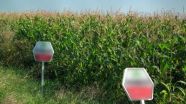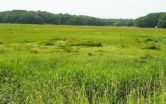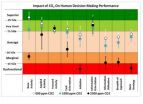USDA scientists collaborate with global researchers to advance the mapping of the barley genome
2012-10-18
(Press-News.org) WASHINGTON, October 17, 2012--In a major advance that will unlock the benefits of the mapping of the barley genome--one of the world's most important cereal crops--work conducted and supported by the U.S. Department of Agriculture (USDA) in collaboration with researchers around the world has resulted in the most advanced sequencing of the barley genome to date, as reported today in the journal Nature. The advance will give researchers the tools to produce higher yields, improve pest and disease resistance, and enhance nutritional value of barley. Past genomic research supported by USDA has provided similar benefits to crops such as tomato and corn, and helped improve cattle breeding and enhance the productivity of dairy cows.
"USDA supports innovative genomics research that is really moving us forward to meeting the many challenges we face in food, fuel and agriculture production," said Catherine Woteki, USDA's Chief Scientist and Under Secretary for Research, Education, and Economics. "This important step toward full barley genome sequencing offers enormous potential for global food security. Using the tools of genetics and genomics, we are keeping farmers profitable and our food supply safe and abundant."
Along with project investigators Timothy Close and Stefano Lonardi at the University of California, Riverside (UCR) and Gary Muehlbauer at the University of Minnesota, supported by grants from USDA's National Institute of Food and Agriculture (NIFA), USDA's Agricultural Research Service (ARS) scientists Roger Wise and Jesse Poland, together with scientists from 19 other organizations around the world, make up the International Barley Sequencing Consortium (IBSC).
Nearly twice as large as the human or maize genomes, the barley genome was a challenge to sequence, due to its complexity and its large proportion of repetitive regions, which are difficult to piece together into a true linear order. By developing and applying a series of innovative strategies that allowed them to circumvent these difficulties, the IBSC created a high-resolution assembly that places the majority of barley genes in order. This new resource provides the sequences of nearly all genes and associated regulatory regions, which will offer new direction to researchers seeking to improve barley yield and quality through functional genomics (determining the functions of important barley genes) and genomics-assisted breeding.
The work of IBSC highlighted in Nature provides a detailed overview of the functional portions of the barley genome, revealing the order and structure of most of its 32,000 genes and a detailed analysis of where and when genes are switched on in different tissues and at different stages of development. They describe the location of dynamic regions of the genome that carry genes conferring resistance to devastating diseases, such as powdery mildew, Fusarium head blight and rusts. This will provide a far better understanding of the crop's immune system. The achievement will also highlight with unprecedented detail the genetic differences among barley cultivars.
The success of the barley genome sequencing, and other grass family crops including wheat and rye, will allow breeders and scientists to effectively address the challenge of feeding the world's growing population living in an environment that increasingly challenges farmers and ranchers with extreme weather events.
INFORMATION:
The Nature paper can be found at: http://www.nature.com/nature/journal/vaop/ncurrent/full/nature11543.html.
For more information on the IBSC, please visit: www.barleygenome.org.
END
ELSE PRESS RELEASES FROM THIS DATE:
2012-10-18
When facing a difficult choice, many of us turn to that old standby: the pro-con list. A University of Washington project takes election pro-con lists to the next level, moving them online and allowing voters to work together to draft points – brief arguments for or against – and refine their positions.
Now in its third year, the Living Voters Guide, presented in partnership with Seattle's CityClub, just won a regional award and has been updated for the 2012 election. This year the guide has expanded to include a California edition, and the Washington guide will include ...
2012-10-18
In Europe there are many concerns about adverse environmental effects of GM crops, and the opinions on the outcomes of environmental risk assessments (ERA) differ largely. GM crop safety testing and introduction studies among the regulatory system are insufficiently developed. Therefore the proposed framework aims at improving the regulatory system.
Specific elements of the network are a) methodologies for both indicator and field site selection for GM crop ERA and PMEM, b) an EU-wide typology of agro-environments, c) a pan-European field testing network using GM crops, ...
2012-10-18
MADISON – In 1986, when Voyager swept past Uranus, the probe's portraits of the planet were "notoriously bland," disappointing scientists, yielding few new details of the planet and its atmosphere, and giving it a reputation as a bore of the solar system.
Now, however, thanks to a new technique applied at the Keck Observatory, Uranus is coming into sharp focus through high-resolution infrared images, revealing in incredible detail the bizarre weather of the seventh planet from the sun.
The images were released in Reno, Nev. today (Oct. 17, 2012) at a meeting of the ...
2012-10-18
MINNEAPOLIS / ST. PAUL (10/17/2012) —An international team of researchers, including a University of Minnesota scientist, has developed an integrated physical, genetic and functional sequence assembly of the barley genome, one of the world's most important and genetically complex cereal crops. Results are published in today's issue of Nature.
The advance will give researchers the tools to produce higher yields, improve pest and disease resistance, and enhance the nutritional value of barley.
Importantly, it also will "accelerate breeding improvements to help barley ...
2012-10-18
CHICAGO—Consumers are increasingly demanding the development of ready-to-eat gluten and lactose-free food products that meet their needs and help improve their health. A recent study in Journal of Food Science, published by the Institute of Food Technologists (IFT), shows how new white sauce formulations are being created to meet these demands.
Consumers with celiac disease often find that gluten-free products are of inferior quality compared with their traditional, non-gluten-free counterparts. Traditional white sauce is made with milk, flour or starch, oil, and salt. ...
2012-10-18
CHICAGO- With over a thousand different varieties of mangoes to choose from, selecting the right variety for mango products can be a daunting task. A new study in the Journal of Food Science, published by the Institute of Food Technologists (IFT), explores the impact that processing has on the flavor and texture of mango varieties. Findings suggest that processing plays an important role in determining the flavor and texture of the final product.
Researchers at Kansas State University studied the flavor and texture of four different mango varieties as they were processed ...
2012-10-18
Salt marshes have been disintegrating and dying over the past two decades along the U.S. Eastern Seaboard and other highly developed coastlines without anyone fully understanding why.
This week in the journal Nature, scientist Linda Deegan of the Marine Biological Laboratory (MBL) in Woods Hole, Mass., and colleagues report that nutrients--such as nitrogen and phosphorus from septic and sewer systems and lawn fertilizers--can cause salt marsh loss.
"Salt marshes are a critical interface between the land and sea," Deegan says. "They provide habitat for fish, birds ...
2012-10-18
New research from Mount Sinai School of Medicine sheds light on how overeating can cause a malfunction in brain insulin signaling, and lead to obesity and diabetes. Christoph Buettner, MD, PhD, Associate Professor of Medicine (Endocrinology, Diabetes and Bone Disease) and his research team found that overeating impairs the ability of brain insulin to suppress the breakdown of fat in adipose tissue.
In previous research Dr. Buettner's team established that brain insulin is what suppresses lipolysis, a process during which triglycerides in fat tissue are broken down and ...
2012-10-18
CHICAGO—According to the World Health Organization (WHO), 63 percent of the deaths that occurred in 2008 were attributed to non-communicable chronic diseases such as cardiovascular disease, certain cancers, Type 2 diabetes and obesity—for which poor diets are contributing factors. Yet people that live in societies that eat healthy, plant-based diets rarely fall victim to these ailments. Research studies have long indicated that a high consumption of plant foods is associated with lower incidents of chronic disease. In the October issue of Food Technology magazine, Senior ...
2012-10-18
Overturning decades of conventional wisdom, researchers at the Department of Energy's Lawrence Berkeley National Laboratory (Berkeley Lab) have found that moderately high indoor concentrations of carbon dioxide (CO2) can significantly impair people's decision-making performance. The results were unexpected and may have particular implications for schools and other spaces with high occupant density.
"In our field we have always had a dogma that CO2 itself, at the levels we find in buildings, is just not important and doesn't have any direct impacts on people," said Berkeley ...
LAST 30 PRESS RELEASES:
[Press-News.org] USDA scientists collaborate with global researchers to advance the mapping of the barley genome



